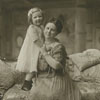Photography and the Making of a Popular, Colonial Monarchy in the Netherlands East Indies during Queen Wilhelmina’s Reign (1898-1948)
DOI:
https://doi.org/10.18352/bmgn-lchr.10140Keywords:
Foto's, MonarchyAbstract
Photography and the Making of a Popular, Colonial MonarchyThe Netherlands East Indies during Queen Wilhelmina’s Reign
(1898-1948)
Public celebrations in the Dutch East Indies (colonial Indonesia) for the House of Orange during Queen Wilhelmina’s reign were of an historically unprecedented scale and frequency, regularly attended by large crowds and reported in newspapers. Scholars typically emphasize the leading role of colonial elites in orchestrating these festivals, and the symbolic importance of the monarchy as a conservative institution that bound the colony to the metropole. The agency of spectators and non-elite participants, and the extent to which a popular ‘oranjegevoel’ (Orange-sentiment) can be said to have existed in the colonies, remains to be demonstrated. This article uses a range of popular photographic sources – amateur photographs in personal albums, and published photographs of the Dutch monarchy in private collections as well as commemorative books – to examine the meanings that ordinary people in the Indies derived from engaging with the House of Orange through images. Susie Protschky argues that, for many Indies residents, photographs of royal celebrations and the Dutch monarchy enabled the cultivation of transnational networks and cosmopolitan identities, and integrated international events into colonial and family histories.
Fotografie en de wording van een koloniale ‘volksmonarchie’. Nederlands-Indië ten tijde van koningin Wilhelmina (1898-1948) Openbare Oranjefeesten in Nederlands-Indië waren tijdens de regering van koningin Wilhelmina van een historisch ongekende omvang en frequentie. De feesten werden regelmatig bijgewoond door een groot publiek en er werd over geschreven in de kranten. Historici benadrukken meestal de leidende rol van de koloniale elite tijdens de organisatie van deze vieringen of de symbolische betekenis van de monarchie als een conservatieve instelling die de banden tussen kolonie en het moederland versterkt. De rol van toeschouwers, deelnemers aan deze feesten die niet uit de elite afkomstig waren, en de mate waarin een ‘oranjegevoel’ in de koloniën bestond, zijn vooralsnog onderbelicht gebleven. In dit artikel worden diverse populaire fotografische bronnen – amateurfoto’s uit privéalbums en gepubliceerde foto’s van de Nederlandse monarchie in privécollecties en gedenkboeken – gebruikt om te onderzoeken welke betekenis gewone mensen in Nederlands-Indië aan de monarchie ontleenden. Susie Protschky beargumenteert dat voor veel bewoners van Nederlands-Indië de foto’s van de Oranjefeesten en de Nederlandse monarchie de ontwikkeling van transnationale netwerken en kosmopolitische identiteiten bevorderden, en dat zij internationale gebeurtenissen integreerden in koloniale- en familiegeschiedenissen.
Downloads

Published
Issue
Section
License
Authors who publish with this journal agree to the following terms:
a) Authors retain copyright and grant the journal right of first publication with the work simultaneously licensed under a Creative Commons Attribution 4.0 International (CC BY 4.0) that allows others to share the work with an acknowledgement of the work's authorship and initial publication in this journal.
b) Authors are able to enter into separate, additional contractual arrangements for the non-exclusive distribution of the journal's published version of the work (e.g., post it to an institutional repository or publish it in a book), with an acknowledgement of its initial publication in this journal.
c) Authors are permitted to post their work online (e.g., in institutional repositories or on their website) prior to and during the submission process.
Authors are explicitly encouraged to deposit their published article in their institutional repository.











